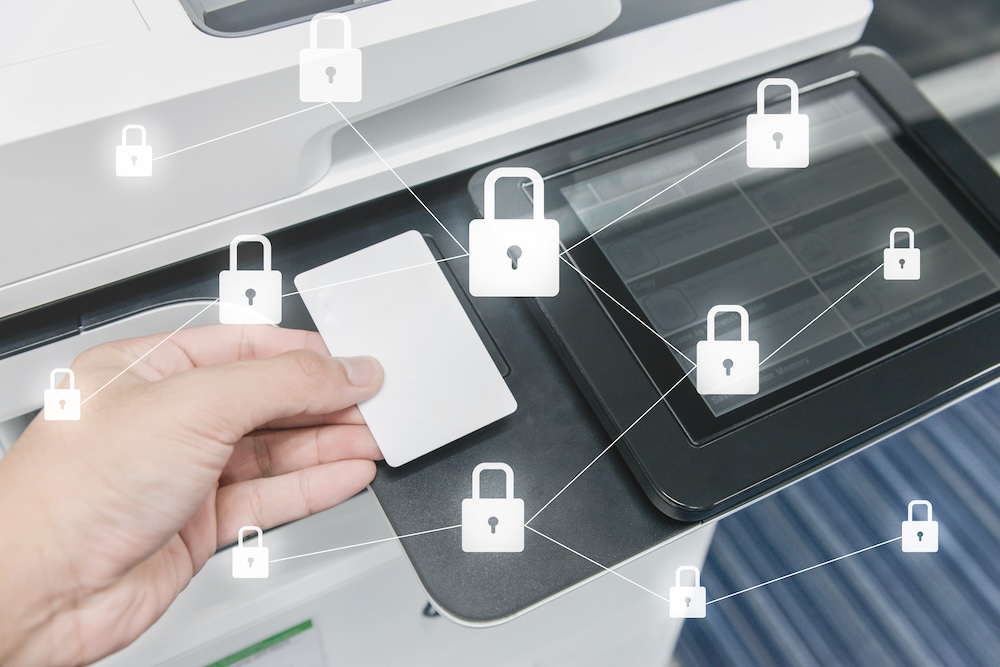Many small and mid-sized businesses spend a lot of time securing laptops, servers and cloud accounts. Printers don’t always get the same attention, even though they process some of the most sensitive documents a company handles. Payroll reports, customer invoices, HR files, financial summaries and confidential project notes all pass through a print device at some point. If print traffic isn’t encrypted, anyone with access to the network could intercept or view that information.
Print job encryption protects documents while they travel from a computer to a print server, then on to the printer. It also protects the data stored on the device during processing. For SMBs, this is a practical way to reduce the risk of data loss and meet growing compliance expectations. The good news is that you do not need an enterprise-sized budget to secure your print environment. The Apply, Validate and Maintain model gives SMBs a simple framework that can be used to strengthen print security without creating more complexity.
Apply: Setting Up Print Job Encryption the Right Way
The Apply phase focuses on creating a secure foundation. This is where you configure encryption settings, adjust network paths and set the rules that control how print jobs move through your environment.
1. Enable encryption between workstations and the print server
The first step is to make sure the communication from each user’s computer to the print server is encrypted. This is typically done with TLS or SSL. These protocols prevent anyone on the network from capturing or reading print traffic. Without this protection, print jobs may pass across the network as plain text. That means document contents could be visible to anyone who knows how to intercept unprotected traffic. Enabling TLS is usually a quick configuration change, but it has a significant impact on data safety.
2. Secure the path from the print server to the printers
Once the workstation to server path is encrypted, the next step is to secure the communication from the server to the print device. Many modern printers support secure, encrypted communication through IPPS. When this option is available, it should be used because it ensures that print traffic remains protected throughout the journey. It is important to confirm that the device firmware supports strong security protocols. If a printer has not been updated in years, it may not provide current encryption standards.
3. Turn on secure print release or hold print workflows
Printed pages sitting on an output tray remain one of the most common causes of unintended exposure. Someone prints a confidential file, forgets to pick it up, and another person walks by and sees it. Secure print release eliminates this problem. With this feature, the print job stays encrypted and waits in a queue. It only prints after the authorized user signs in at the device with a PIN code, card swipe or mobile release option. This simple workflow protects documents after they leave the network and before they are picked up by the right person.

4. Enforce user authentication and access controls
Print security requires awareness of who is printing and what they are printing. Authentication ensures that only approved users have access to specific printers or print queues. It can also restrict color usage, limit access to certain devices or control printing based on departments. Authentication strengthens encryption because it prevents unauthorized users from sending jobs to a device that is configured for sensitive documents.
5. Use vendor recommended security settings
Major printer manufacturers provide built in security profiles. These profiles bundle recommended encryption and hardening settings into one easy package. They often include automatic updates, secure protocols, certificate settings and restrictions on older communication methods. SMBs gain reliable protection without needing to customize dozens of advanced settings.
Validate: Making Sure Your Print Encryption Works
Once encryption is applied, the next step is to confirm that everything is working. Validation is an ongoing process rather than a one-time setup. It helps SMBs identify problems early and ensure that print jobs stay protected.
1. Confirm encrypted job paths
Administrators should regularly review print queue properties to confirm that encryption is active. If a driver update or workstation change causes the system to fall back to an unencrypted path, print jobs may no longer be secure. Validation can be done with simple checks within the print server or printer administrative console. The goal is to verify that communication is protected at every step.
2. Conduct a basic print security review
Even small reviews can reveal overlooked issues. For example, a device may log repeated connection attempts from an unknown workstation. A test print might bypass the encrypted queue and use an older protocol. A print server may show jobs traveling through non encrypted ports. These details matter because a single weak point in the chain weakens the entire environment.

3. Test secure release workflows
Secure print release should be tested with multiple users to ensure it cannot be bypassed. For example, print a document and confirm that it remains in the queue until released at the device. Attempt to release it without authentication to verify that the system blocks access. Check that jobs do not appear on other printers by accident. These tests protect the business from avoidable mistakes and oversights.
4. Validate firmware and software versions
Printers need current firmware to support encryption. Old firmware may not support newer TLS versions or may contain vulnerabilities. The print server and print drivers also need updates to maintain compatibility and security. This is particularly important after operating system updates because new OS versions can change how print traffic is handled.
5. Look for gaps in the environment
Validation also means reviewing the environment for hidden issues. For example, remote employees might print through unsecured networks. A department might have added a small desktop printer that does not support encryption. A cloud print app may send jobs through a non-encrypted path. These gaps need to be addressed to keep the encryption model intact.
Maintain: Keeping Print Job Encryption Strong Over Time
Technology evolves. Staff changes. Devices are replaced. Workflows shift. Encryption must be maintained as the environment grows and changes. The Maintain phase ensures long term protection.
1. Keep devices and print software updated
Printers receive firmware updates that improve security, add encryption support or fix vulnerabilities. Print servers and drivers receive updates as well. A routine maintenance schedule prevents outdated components from weakening your security.
2. Review encryption and security settings regularly
Settings can drift over time. New drivers may override older configurations. Devices may reset after repairs. Reviewing settings on a monthly or quarterly basis helps prevent accidental gaps in protection.
3. Monitor print logs for unusual activity
Print logs provide insight into suspicious behavior. If logs show printing during unusual hours or repeated failed attempts to release jobs, this can signal a security issue. Monitoring does not need to be complicated. Even basic visibility helps SMBs stay aware of what is happening.
4. Re-validate after adding or replacing equipment
Whenever you add a new printer, replace a workstation or update your network, the encryption path should be re checked. This step makes sure the new equipment follows the same security rules and does not open unintended access points.
5. Provide simple guidance to employees
Training does not need to be formal or complex. A few reminders are often enough. For example, release print jobs promptly, avoid printing through public networks, and report anything unusual at the device. These small habits help maintain the effectiveness of encryption.
How a Managed Print Services Provider Can Help
Many SMBs want strong print security but do not have the time or staff to manage encryption, updates and monitoring. A Managed Print Services provider can support this process and ensure print job encryption remains reliable.

1. Secure configuration from the start
An MPS provider configures encryption correctly, sets up secure communication paths, enables secure release and adjusts device settings. The setup is done based on your needs and the types of documents your business handles.
2. Routine validation and security checks
Instead of waiting for problems, the provider reviews logs, device settings and print paths to confirm encryption remains active. They identify weak spots such as unsecured personal printers, outdated drivers or new devices that were added without proper configuration.
3. Ongoing maintenance
The provider manages firmware updates, software patches, and driver changes on a schedule. This prevents outdated components from weakening your encryption settings.
4. Monitoring and reporting
Managed Print solutions offer centralized dashboards that show print usage, authentication issues and potential risks. This gives your team better visibility and helps identify unusual behavior.
5. Support for remote and hybrid staff
Remote printing can create security concerns. An MPS provider helps secure home office printing, cloud printing and mobile printing so encryption stays intact outside the office.
6. Fast problem resolution
If something breaks, the provider can take care of it. SMBs avoid downtime and prevent users from working around encryption due to frustration.
7. Long-term planning
As your business grows, the provider helps you plan for new equipment, better workflows and stronger security protections.
Encryption Gives SMBs a Clear Path to Safer Printing
By following a clear process that covers applying the right settings, validating that everything works and maintaining protection over time, businesses can keep sensitive documents safe from the moment they are sent to the moment they are picked up from the device.
This practical approach helps reduce risk, strengthens compliance efforts and gives staff confidence that printed information stays private. Whether your team manages the process on its own or relies on a Managed Print Services partner, encryption remains one of the most effective ways to protect every document that leaves your network.
About United Business Systems
United Business Systems specializes in simplifying the complexity and management of office technology solutions for over 7,800 organizations nationwide. Services include Managed Print, Document Management and IT Services. Products include MFPs, Copiers, Printers and Wide Format Printers. UBS’s headquarters is in Fairfield, NJ with branch offices in Moorestown, NJ, Manasquan, NJ and New York.For the latest industry trends and technology insights visit UBS’ main Blog page.


